 |
| |
MI6 trawls the archives to see how critics of
the day received Timothy Dalton's second and final
outing as James Bond in the
1989 film "Licence To Kill"...
|
|
Time Tunnel: Review Rewind
14th June 2009
New York Times - July 14th,
1989
When Sean Connery was James Bond, a time many still consider
the Golden Age, he was smoother than a dry martini, faster
than an Aston Martin, practically able to leap from tall buildings
and land in a woman's bed. His sardonic secret agent for the
1960's gave way to Roger Moore's infinitely more urbane Bond;
the Moore 007 always seemed more comfortable sipping Dom Perignon
than a shaken-not-stirred martini. And now Timothy
Dalton promises
to become the first James Bond with angst, a moody spy for
the fin de siecle.
Though ''Licence
to Kill''
is his second appearance as 007, Mr. Dalton is still the
new James Bond, and the only element in the 27-year-old
series that can offer a hint of surprise. The film retains
its familiar, effective mix of despicably powerful villains,
suspiciously tantalizing women and ever-wilder special
effects. But Mr. Dalton's glowering presence adds a darker
tone. The screenwriters Michael G. Wilson and Richard Maibaum
have accommodated this moodier Bond, and have even created
a script that makes him fit for the 90's.
The story begins in Key West, Fla., where Bond and his
friend, a United States Drug Enforcement Agent named Felix
Leiter, take a detour on their way to Leiter's wedding.
Before the title credits roll, Bond takes a short ride
on top of a small plane to capture a Latin American drug
lord and political tyrant named Sanchez, a topical villain
who seems unmistakably modeled on Gen. Manuel Antonio Noriega. |
|
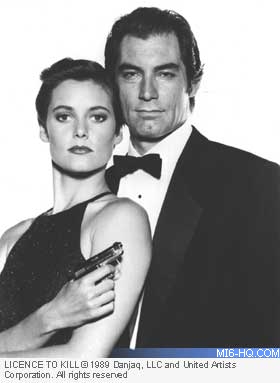 |
When Sanchez escapes and literally throws Bond's
best friend to a shark, 007 gnashes his teeth with grief, scowls
at the ineptitude of the American officials and vows to get Sanchez
himself. Bond's superior, M, revokes his license to kill, an
order that does nothing to slow him down. He simply moves on
to Isthmus, the fictional country where Sanchez lives in a seaside
mansion with all the garish furnishings drug money can buy.
The plot, of course, hardly matters, as long as it keeps Bond
moving. Over the years, it has become harder for the series to
keep up with all the splashy special-effects films it helped
to inspire. Though ''Licence to Kill'' is more volatile than
''The Living Daylights,'' Mr. Dalton's first Bond film, it may
seem tame next to hyperactive movies like ''Lethal Weapon 2.''
Here Bond faces a ninja and makes several underwater escapes.
But the spectacular action is saved for the big final shootout,
involving a convoy of tank trucks carrying cocaine-spiked gasoline;
the possibilities for reckless driving, exploding trucks and
flying bodies on a fiery, winding road are countless.
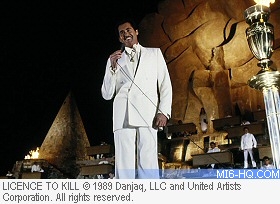
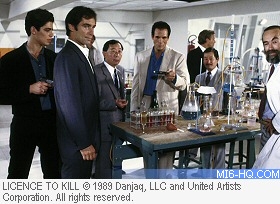
|
|
The nonviolent action includes
a duel for Bond's affection, such as it is. Talisa
Soto is Sanchez's disillusioned lover, Lupe Lamora, eager to
betray him with just about anybody, but especially with
Bond. And Carey Lowell becomes the most playful, modern
Bond heroine in years as Pam Bouvier, a former Army pilot
who helps to outwit Sanchez. When she and 007 meet in a
dingy Bimini bar, Pam carries a gun much bigger than Bond's
and seems at least as seductive and tough as he is. But
in Isthmus, Bond forces her to pose as his secretary, introducing
her as Miss Kennedy. ''It's Ms. Kennedy, and why can't
you be my executive secretary?'' she asks, and Bond answers
suavely, ''It's south of the border; it's a man's world.''
This ruse is a clever way for the writers to preserve,
if only for old time's sake, some of Bond's traditional
macho chauvinism, and it doesn't prevent Pam from packing
a gun in her garter.
The endearing special-weapons wizard Q (Desmond Llewelyn) also arrives in Isthmus. He carries
a satchel full of new toys, including an exploding alarm
clock ''guaranteed never to wake up anyone who uses it.'' |
And in a bit of casting that is literally inspirational, Wayne
Newton plays a slimy television evangelist whose ministry is
a front for the drug operation. Clients phone in their pledges
in a dial-a-drug scheme where a $500 donation means an order
for 500 kilos of coke.
For all its clever updatings, stylish action and witty escapism,
''Licence to Kill,'' which opens today at Loews Astor Plaza and
other theaters, is still a little too much by the book. Mr. Dalton
is perfectly at home as an angry Bond, and as a romantic lead
and as an action hero, but he never seems to blend any two of
those qualities at once. He does not seem at ease with all of
Bond's lines, and to the actor's immense credit he seems least
comfortable when M meets him at Hemingway's house, a Key West
tourist attraction, and tells him to turn over his gun. ''I guess
it's a farewell to arms,'' says Mr. Dalton, not quite cringing.
They have to stop writing lines like that for the Dalton Bond,
or he'll really be full of angst. Meanwhile, he is beginning
to hold his own with the shadows of his former self.
Variety - July, 1989
The James Bond production team has found its second wind with
Licence to Kill, a cocktail of high-octane action, spectacle
and drama.
Presence for the second time of Timothy Dalton as the sauve British agent
clearly has juiced up scripters, and director John Glen.
Out go the self-parodying witticisms and
over-elaborate high-tech gizmos that showed pre-Dalton
pics to a walking pace. Dalton plays 007 with a vigor and
physicality that harks back to the earliest Bond pics,
letting full-bloodied actions speak louder than words.
The thrills-and-spills chases are superbly orchestrated
as pic spins at breakneck speed through its South Florida
and Central American locations. Bond survives a series
of underwater and mid-air stunt sequences that are above
par for the series.
|
|
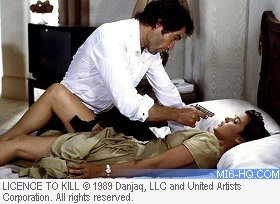 |
He's also pitted against a crew of sinister baddies (led by
Robert Davi and Frank McRae) who give the British agent the chance
to use all his wit and wiles. Femme elements in the guise of
Carey Lowell and Talisa Soto add gloss but play second fiddle
to the action
Time - July 24th,
1989
You can hear the clockwork sputtering inside the brawny breastplate
of this week's heroids: Los Angeles supercop Martin Riggs (Mel
Gibson) in Lethal Weapon 2 and Her Majesty's secret servant James
Bond (Timothy Dalton) in Licence to Kill. Both men are rogue
avengers, out for bloody justice against cartels that have killed
or threatened their partners and spouses. Both pictures, with
their suavely depraved drug lords and curt disregard for constitutional
safeguards, play like extended episodes of Miami Vice. Both scenarios
choose their villains from the current list of least favored
nations: South Africa in LW2, a thinly disguised Panama in Licence. "Remember," Bond's
nemesis (Robert Davi) warns the film's Noriega, "you're
only President for Life."
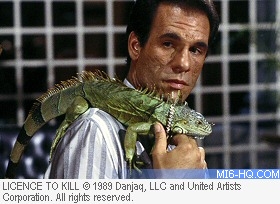
|
|
In Licence to Kill, the
bad guys' hideaway blows up real good too. And there are
some great truck stunts. A pity nobody -- not writers Michael
G. Wilson , and Richard Maibaum nor director John Glen
-- thought to give the humans anything very clever to do.
The Bond women are pallid mannequins,
and so is the misused Dalton -- a moving target in a Savile
Row suit. For every
plausible reason, he looks as bored in his second Bond
film as Sean Connery did in his sixth. |
Licence's only innovation comes in the closing
credits. To atone for Bond's use of cigarettes, the producers
print the Surgeon General's caveat on the evils of tobacco.
Related Articles
 James Bond Time Tunnel
James Bond Time Tunnel
 Licence
To Kill -
Movie Coverage
Licence
To Kill -
Movie Coverage